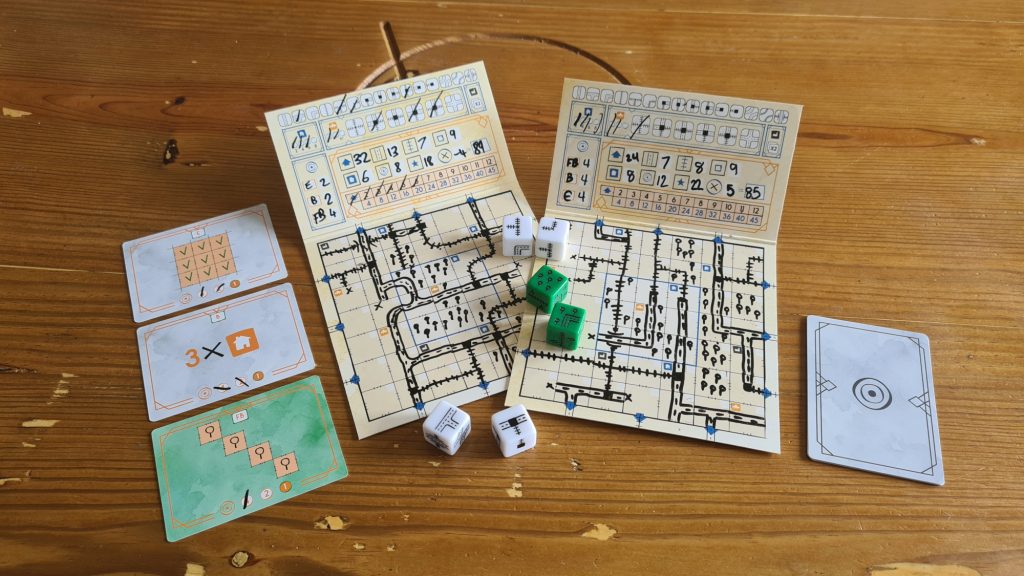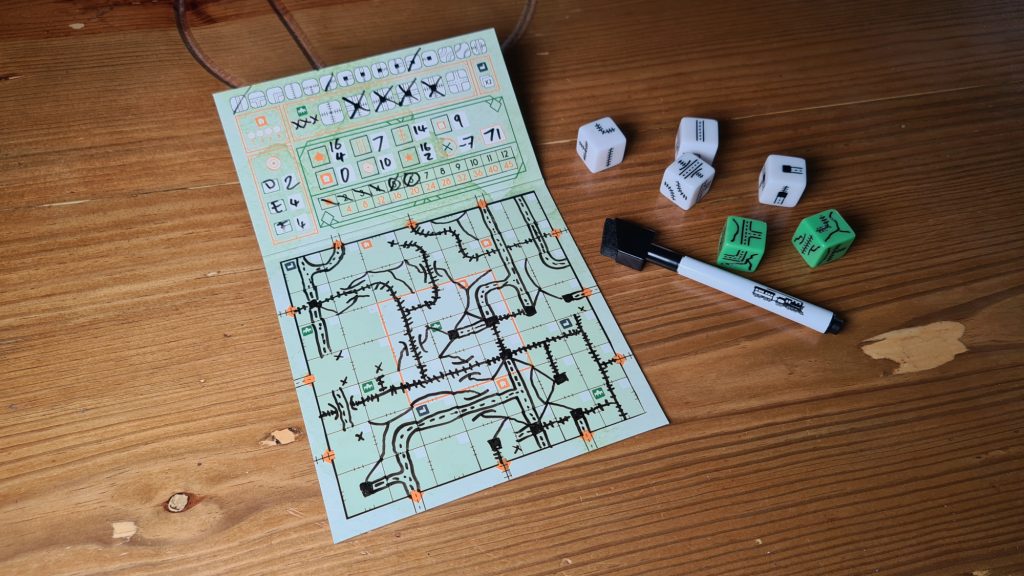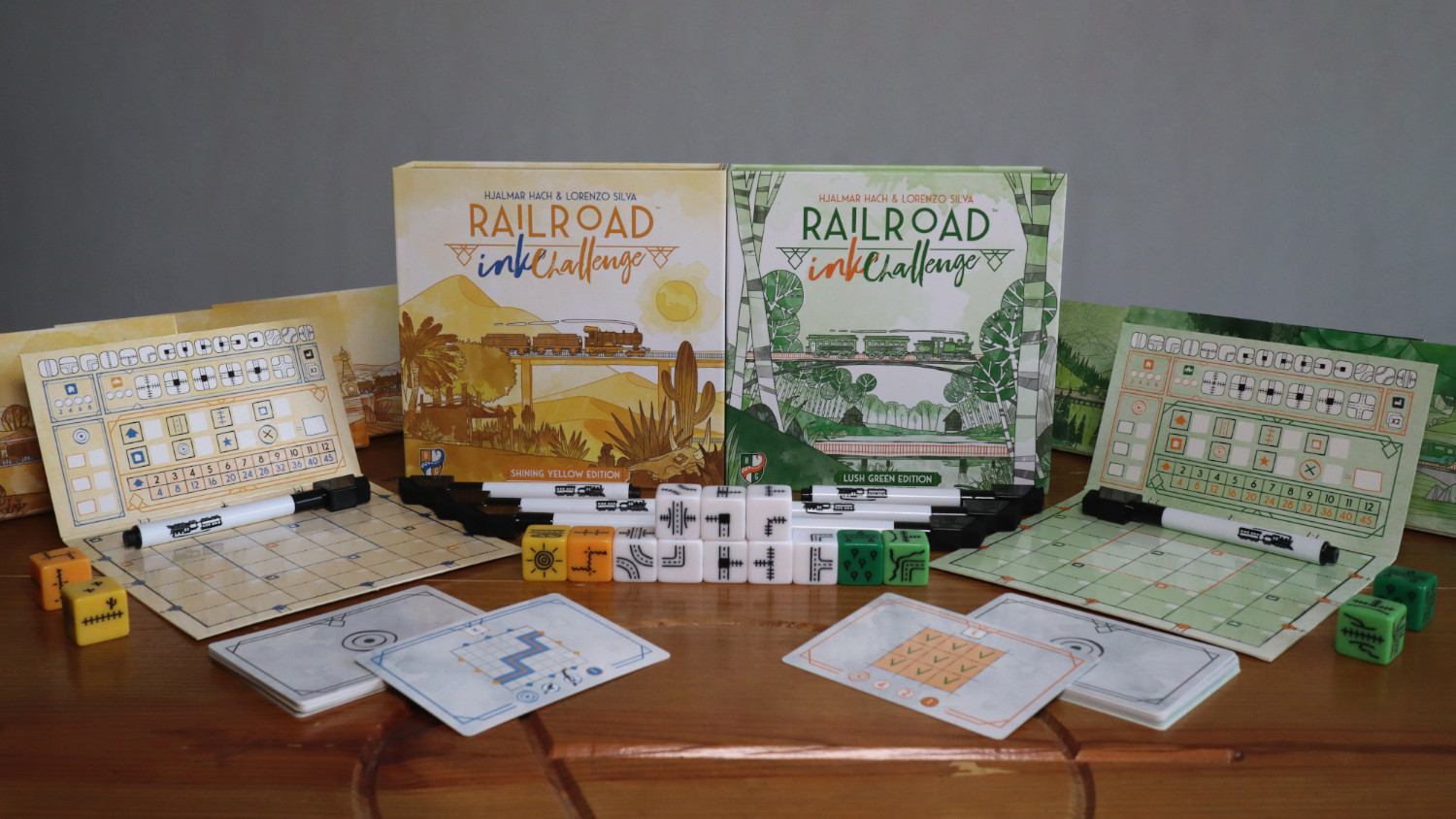Railroad Ink Challenge Lush Green and Shining Yellow are the brand new roll and write board games from Horrible Guild. Designed by Hjalmar Hach and Lorenzo Silva, featuring artwork from Marta Tranquilli, the game sees 1 – 4 players sketch out railways and highways, making hopefully huge point scoring networks. Lasting around 20 minutes, Lush Green and Shining Yellow introduce forests, trails, canyons and cacti into the mix. However, are these positive additions to what was an amazing original game? Let’s find out!
Releasing simultaneously the two editions offer the same core game experience but differ with unique expansions and goal cards – on top of the obvious colour palette changes. The two Railroad Ink Challenge titles work almost the same as the previous Railroad Ink titles (Deep Blue and Blazing Red). There are a few tweaks to the core of the game, though much of the same logic stands. If you would like to know how they worked the review can be found here.
In Railroad Ink Challenge players will roll a communal pool of route dice each round, and then all simultaneously draw the faces of the dice onto their own player boards. The dice feature a range of railways and highways, sometimes crossing each other or connecting via stations. There are limitations to follow, with railways unable to connect directly into highways and vice versa. Also, when adding to the networks players can only add on to an existing network or start a new one from one of the many exit points – located around the edge of the player board.
New to Railroad Ink Challenge are goal cards, universities, villages and factories. Each box includes 6 goal cards, with 3 randomly chosen for each game. These range from wanting to make a loop in your network to linking two opposite sides of the board together in a network, with players earning more points if they do it fastest. Each of the expansions also have goal cards, with these adding a good amount of variety into the experience – especially when combining the pool of goal cards from the two sets.

Universities, villages and factories are all special buildings on the player boards. Universities and Factories trigger if a player builds a railroad or a highway on the space they are denoted on. Triggering 3 universities rewards the player with a free special route placement, allowing them up to four uses in that game. Triggering factories also gives an instant reward, allowing the player to duplicate a route die rolled that round! Villages are a little different, scoring two points at the end of the game if they have a station drawn on their indicated spaces.
Players gain the majority of their points from the number of exits they manage to link together in networks. They also recieve points for many other aspects such as their longest railway and highway, for filling in the 9 spaces in the middle of the player boards and villages that have stations. Players still lose points, like in Railroad Ink, for deadends on their routes, with points calculated and the winner crowned.
The biggest difference between the two sets is not the goal cards included, it’s the expansions. Lush Green comes with 2 forest and 2 trail dice, while Shining Yellow comes with 2 desert and 2 canyon dice. When using any of the expansions players play only 6 rounds, instead of 7, rolling the dice of their chosen expansion alongside the route dice. In each of these expansions players can decide whether or not to use the expansion dice.
Forests are rated as an easy expansion, adding trees alongside some railway/highway pieces. Scoring points based on adjacent groups of trees, this is very much a small addition – where being greedy for the bonus points can screw you over. Desert from Shining Yellow is similar in terms of being very much a small side addition. In this players score points for all of their cacti at the end of the game but they can be destroyed if the arid sun face is rolled and players don’t have nearby oases.

Trails and Canyons are more complicated, adding much more to think about around the edges of spaces. Trails want to be linked to stations – scoring similar to networks. With them winding along the edges of the Trails dice they are hard to link up correctly to score big. Canyons are also drawn along the edges of spaces, adding another place to keep an eye on during play. One of your canyons scores at the end of the game based on its length, with 1 point per segment, with a bonus of 2 points per individual canyon. Described as hard these certainly turn the easy to play game into a gamer’s game with plenty to think about on a turn.
The addition of features on the board and the goal cards adds complexity to what is otherwise a gateway roll and write title. For gamers the special buildings on the boards are epic little bonuses that can be triggered to gain bigger turns. These little extras make a turn feel much more impactful – especially when expansion dice are involved – as players can fill in plenty more than the 4 route dice faces on a turn. The goal cards add additional things to aim for, often making players choose otherwise less optimal placements in order to score the bonus points. There is also the added fun of the interaction between players trying to achieve the goal cards quickest.
There is a downside to these otherwise brilliant additions though, as they have a negative impact on the ease of play. That first game for a new player has those few extra things to learn and remember. They aren’t even end game scoring opportunities either, all triggering during play – so I can see brand new players flicking back to rulebook to clarify things – something that never occurred with the original Railroad Ink games. The rulebook does suggest leaving the goal cards out for an easier experience. I’d go one further for new players to suggest ignoring the special buildings on the player boards too. After a game players will be up to speed with the rest and be able to enjoy these as the little extras they are though.
As with the original Railroad Ink games, Railroad Ink Challenge is hard to fault on a component front. Coming with laminate finish boards and cards, players can doodle over them during play and just wipe the dry erase markers off afterwards. It’s also hard to fault the game on a gameplay front, with easy to teach rules and plenty of choices to be made throughout the experience. It is important to note that the original games included 6 player boards and markers, while these new editions only include 4. This is perhaps to encourage gamers to purchase both editions, rather than just one. With the ability to mix and match goal cards and the range of expansion dice, having both in a collection certainly isn’t out of the question. Whether you pick up both, just Lush Green or Shining Yellow, there is a lot to love about this little roll and write!
(Editor’s Note: Railroad Ink Challenge Lush Green and Shining Yellow were provided to us by Asmodee for the review. Both games are currently available from local board game stores! Find your local store here.)

